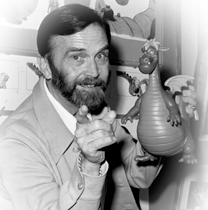 SUSPENDED ANIMATION #239
SUSPENDED ANIMATION #239
Ken Anderson’s official credits list such titles at Disney as art direction, art supervision, story, color, styling, layout, production, character development and more. Specializing in character design in later years, he designed such characters as Shere Khan in The Jungle Book and Elliott the Dragon in Pete’s Dragon.
I had the opportunity to interview Ken at a The Mouse Club fan convention in 1985 in Anaheim and previously shared an excerpt from that interview here at Cartoon Research.
Jim Korkis: Unlike other Disney animators, you didn’t start out wanting to be a cartoonist or an illustrator.
Ken Anderson: Actually, I was an architect. There wasn’t any architecture work in 1933 when I joined Disney. None. One architect who was busy offered me a job if I paid him thirty-five dollar a month. I had to pay him to work for him but he was the only one in town that seemed to have any business at all.
I did work briefly at MGM where I met folks like Herbie Ryman. I worked there as an architectural set designer on films like Greta Garbo in The Painted Veil (1934). They ran out of work. They were going to close up for two or three months and told me they liked me so to stay by the phone but they never called. When I worked at MGM, I was making good money so I didn’t need any extra work. When I lost that work, I had nothing else.
At this time, I got married. She came down from Seattle and had this beautiful car. I loved her car. We practically lived out of it. We lived on the beach, eating canned beans and such things. I was so happy. One time we drove by the Disney Studio and she said, “Hey, go in there and get a job!” I replied that “I don’t know how to cartoon. I’m an architect. I can draw buildings and people but not cartoons.” My wife said, “Yes, you can” and that was the end of that discussion.
I had a lot of paintings and drawings I had made in Europe during the years I was there. I took them in to Walt not knowing he was interested in that sort of thing. He wanted it. He didn’t have anything like that. He only had the work of cartoonists. Little stick figure kind of things really. No one there was what you would call a fine artist. He was hoping he could upgrade cartoons and get something better.
He looked at the paintings. He liked them very much. I got to try out for two weeks. It was considered a young man’s job at that time because you had to work so hard.
One of the reasons I got out of animation was because in those days, animators were not revered as they are today. They were plebians. A peon. All you did was make it move. You didn’t have a say in anything. You just made these things move. You didn’t have much contact with Walt which is something I wanted very much.
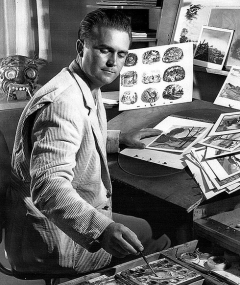 He knew I had an architecture background and he started thinking “there must be some use I can make of that background”. I moved into layout and that was fun. I stayed there because it was a heck of a challenge.
He knew I had an architecture background and he started thinking “there must be some use I can make of that background”. I moved into layout and that was fun. I stayed there because it was a heck of a challenge.
We had what were called “music rooms” which are rooms where we divided everything up into sequences. The things different directors, layout men, animators had to do.
We had a very high-priced director named Dick Huemer. By that, I mean he was a good one. His whole unit. They had a story crew called a “shaping crew”. Walt decided he was going to make things really work but what he needed was a “shaping crew” to “shape” these stories.
The next morning, and remember they don’t tell you anything about when they were showing up, here comes Walt and the crew into Huemer’s music room.
Dick Huemer had just finished shaving himself with this electric razor that looked like this great big malted milk maker thing. A heck of a thing that made a terrible racket.
It was going so fast he couldn’t turn it off and he shoved it in his pocket under the desk and it was still making an awful noise. His pocket was being chewed up and Walt and all these other guys sat down.
It was still going on under Dick’s desk and Dick was struggling to undo it.
Walt said, “Make mine a chocolate malt”.

Anderson (left) with Frank Thomas (right) in the 1970s
JK: You always tell the story about Walt telling everyone the story of Snow White one night before production began and how he was an amazing actor.
KA: We never heard another story from Walt after Snow White. We all waited to hear another story but we never did and before we knew it, we were doing Pinocchio.
Walt thought he was going to be an “artist” artist. But as an actor, he was better than an artist.
His eyebrows became very mobile. He had really moving eyebrows. I think that started when he was young and impersonating Charlie Chaplin. That served him all his life. We could read Walt fairly well if we could look at him. When his eyebrow went up like that, you knew something was going on and it wasn’t the best. If his fingers began to drum and the eyebrows went up too, you knew there was a hell of a lot of stuff going on.
Walt liked people who were active in conversations. He liked people to have ideas. Be excitable and say things that they felt with lots of verve and feeling even if they were wrong.
He said, “(My brother) Roy drives me nuts. The guy just sits there. He’s so patient. He’s a great listener. But he can’t talk. He doesn’t say anything.”
He really wanted to have these exciting conversations.
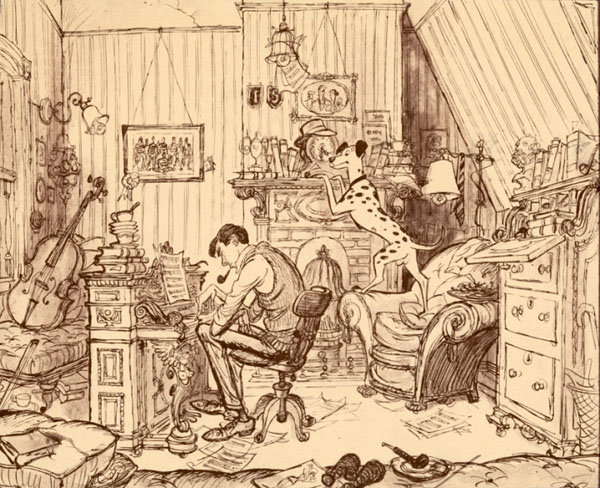
JK: Walt also got excited when he was describing characters.
KA: He was quite an actor. He could act any part. He could be any kind of animal. When we were starting a picture, he would get physically involved. He would be B’rer Bear or B’rer Rabbit. I saw him do it. He would actually be these characters.
You would look at him and he was the rabbit. The next thing he would be a bear. He was doing this thing so we got the idea of these characters. He was the greatest actor we ever saw. He just got carried away with this acting business sometimes.
I remember one time in Arizona where we were doing some live action shooting for Song of the South (1946). We had these outdoor things for the rabbit and the bear and these other characters. This film crew hadn’t seen Walt in action. We couldn’t afford to take our Hollywood crew over. We picked up a crew out there.
We went out on a log. Big ol’ log. Walt said, “Ken, this is just right. This is just what I want.” He would get on the log. He would be B’rer Bear chasing the rabbit and he would chase the rabbit up and around this log. It was the darndest thing you ever saw. You thought you were seeing a bear chasing a rabbit. Walt had the ability to sell us on these particular characters. He made us believe that these characters were doing these actions.
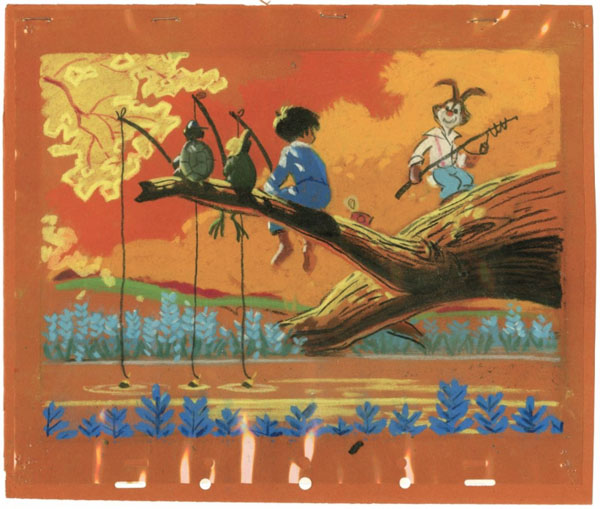


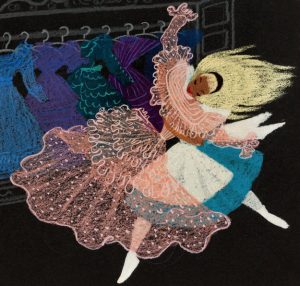
 Jim Korkis is an internationally respected animation historian who in recent years has devoted his attention to the many worlds of Disney. He was a columnist for a variety of animation magazines. With his former writing partner, John Cawley, he authored several animation related books including The Encyclopedia of Cartoon Superstars, How to Create Animation, Cartoon Confidential and Get Animated’s Animation Art Buyer’s Guide. He taught animation classes at the Disney Institute in Florida as well as instructing classes on acting and animation history for Disney Feature Animation: Florida.
Jim Korkis is an internationally respected animation historian who in recent years has devoted his attention to the many worlds of Disney. He was a columnist for a variety of animation magazines. With his former writing partner, John Cawley, he authored several animation related books including The Encyclopedia of Cartoon Superstars, How to Create Animation, Cartoon Confidential and Get Animated’s Animation Art Buyer’s Guide. He taught animation classes at the Disney Institute in Florida as well as instructing classes on acting and animation history for Disney Feature Animation: Florida.




















































Lovely article.
If Disney wants to do remakes why not tackle “Song Of The South”????
You’re kidding, right? I rather have the Live-Action section of the studio tackle “Rip Van Winkle” instead.
Besides, even if they did, it would probably be aimed at Splash Mountain and creating a story around it.
It’s always interesting to read the stories of these early Disney artists. Ken Anderson’s experience as an architect seems to parallel that of the out-of-work engineers who, around this time, became part of the first generation of serious science fiction writers. The Great Depression and its demand for inexpensive entertainment certainly made for some creative career moves!
I’d like to see more of Anderson’s artwork. I like his style.
Fun fact Ken Anderson worked on the Secret of Nimh once Don and some of the other members left the studio.